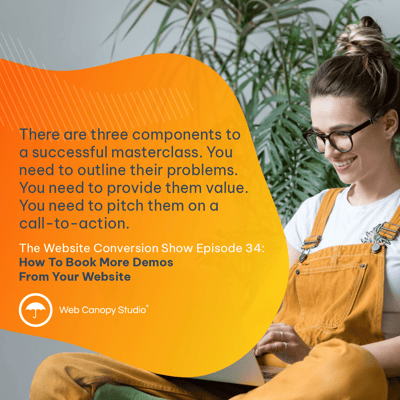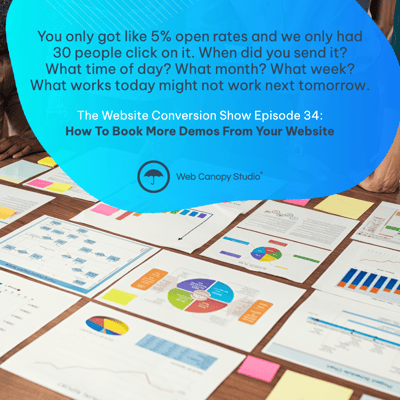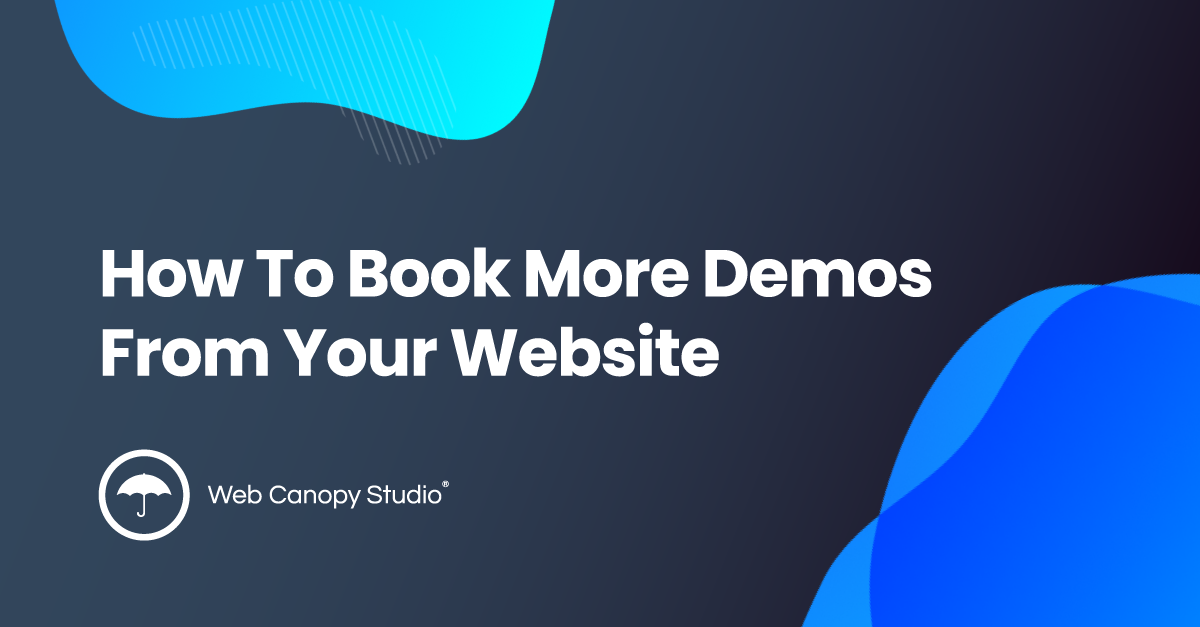Booking demos and sales calls are one of the most difficult things companies do. We're asked by our consulting clients about how they can get more demos booked for their sales team.
Regardless of the size of the business or what you are selling, whether it's a service or a product, the demo is usually the last step — it's the bottom of the sales funnel — before they enter into the sales process.
Let's start with a quick exploration of the buyer's journey, which you're probably familiar with. It's the path that people go through before they make a purchasing decision. You actually go through the buyer's journey when you make a purchase on literally anything, even a pack of gum. You go through different stages of your consideration before making that purchase to see if that's the right purchase for you.
The Buyers Journey
The top of the funnel is where you build awareness. And this is where most companies fall down and do it incorrectly. Most of the time, companies focus a lot on top-of-funnels, lead acquisition, and awareness building. That's when you give something away for free as a lead magnet.
You'll run ads and send emails to generate those leads, and that's important. You'll give people a free digital download, like a report on "The Five Steps to Outlining Your Next Blog Post" or "The 10-Step Checklist for Designing Your Next Website." You have to have interesting content to get top-of-funnel lead acquisitions.
What most people are not very good at is getting those leads to the bottom of the funnel which is where they book a call or demo.
They fall down in the middle part. People just get to the bottom of the funnel by accident or coincidence, not because the companies have successfully moved people from the top to the middle to the bottom.
The reason most people aren't getting to the bottom is that companies have completely eliminated the nurturing stage in the middle.
They skip it completely and try to book a demo right after the person downloaded that digital freebie. They make follow-up calls and emails with messages like, "We hope that report was helpful. Here's a link to book a call so we can show you how we're going to transform your business."
It's like trying to get engaged after the first date. It won't deliver the results that you need.
You're skipping the consideration stage, which is the Middle of the funnel, and barreling straight to the third stage, which is the decision stage, which is the Bottom of the funnel.
The problem is that most people who come to your site are not in a buying position. They're not in a decision state, they're in the awareness state. They're problem aware, maybe even product aware, but they're not ready to go to the next level. You haven't given them enough reason to do that yet.
What you should do is add consideration-level content (Middle of the funnel) to your website. The best way to do this — and this is a big secret that most companies will never do — is to record some kind of master class, tips, strategies, webinar, something that's recorded. You can even do it live if you can get people to show up. But at the very least, record a presentation that walks through the specific topics you want to cover.
Tell them exactly what their problems are and exactly what concerns they have. And show them, "We solve these problems all the time." This way, you're setting yourself up to be an authority in their eyes because they'll see how you can solve that problem for them. Here you're providing nothing but value.

Then the last thing that you'll do in your presentation is pitch them with a call to action. It could be booking a strategy session or getting a free demo of your product.
You'll say, "We've acknowledged you have these problems and given you a step-by-step plan. Now you're at a decision point. You can either 1) take all of this information we've given you and you can implement it on your own. And you're very capable of doing that. You're gonna have road roadblocks. You're gonna go through all these issues and all these things along the way, but you at least are armed with that information."
"Or 2) if you want to fast track through that and solve this problem while saving a lot of time and money, we have a solution that does all of that for you.
I'll walk you through a brief overview, and if that sounds like something you want to do, then I want you to do is book a call with me. Just click on the button below and book a demo so that we get started and just see how this works exactly for your company."
The idea is to get as many people to see this video as possible. To start, draft an email that has all the main points of what you're going to cover. Send it your entire email list, whether it's 200 people or 20,000. Ideally, you'll segment your subscriber list, but you still want to send it to everyone.
After they watch the video, send a follow-up email immediately afterward to everyone who watched the video. And be sure to link to your calendar, like on a Calendly link, so people can schedule the appointment for themselves.
What you don't want to do is have someone send an email on Friday morning and your salesperson doesn't get to it until Monday afternoon. That already creates a crappy experience for the prospect and doesn't convey any kind of warmth or like you're addressing any of their needs. Especially if your video talked about how you make things easier for them. So embed the sale team's calendar directly on your website, underneath the video, so they can easily sign up for a demo or consultation.
As much as 50% of your sales will come from your pipeline and from the follow-up of you engaging with the people who watched the video or engaged with your webinar. That's also when you want to do some kind of segmentation on your email subscription list: who watched it, who didn't, who registered but didn't attend, etc.
Then you'll want to send additional follow-up emails thanking them for watching, encouraging them to read more materials, contact you with questions, and so on. There are a lot of things you can do, but at the bare minimum, just pay attention to who signed up to watch. That follow-up is where you'll get about half of those booked calls. It might take five, six, or seven emails after the video before they actually book the call, but it's worth the effort.
Why? Because it takes on average nine times for people to hear a message before we consider it as an option.
And if you do the follow-up well, go back to the original webinar-invitation emails and try it again. The next week, send it to all the people who didn't open those emails again. Then again the following week to those who didn't open the emails. Why? Because this webinar is booking calls for you. So why wouldn't you want to get as many people into it as possible?

Just remember, what works today might not work next month and what's not working right now could work very well.
For example, we're a website development company. Our bread and butter is helping people get a better experience out of their website, whether that's just content or developing new websites, so they're taking our website courses.
Last December, we sent out a bunch of information about booking calls to talk about websites. And no one booked. No one. My sales calendar was so, so slow for that particular service. But come January, it blew up. We sent out the same invites, the same emails, going out as another reminder.
We had consultations left and right, people trying to get on my calendar. Literally, the only thing that changed was that it was just a different time of year. Different things were going on for different people; their priorities were different.
So try again in a couple of weeks, try again in a couple of months. Doing this will bring you results. You're guaranteed to book calls and demos if you do this and do it regularly.
The Bottom Line
By touching on all three parts of the Buyer's Journey, the Awareness Stage, the Consideration Stage, and the Decision Stage, you can create trust with your leads.
If you do not get the response you want the first time you send out information about your webinar or master class, keep sending it out at different times, as buyers’ priorities shift and change.
If you have not done so yet, go take your free website conversion assessment today. We've built a website conversion framework that goes through all the essential components of what your website has to do in order to be a highly converting website.
We've put together an assessment that you can take on your own that will break down exactly where you're falling short, where you should really focus your energy, and it prioritizes the checklist inside of each of those different categories for you, so you can see where you should spend your time,
The best part is you don't need developers in order to help you make these changes. Most of them are all changes that you, as the business owner, you, as the marketer, you, as the sales director, can actually go in and make by yourself.



